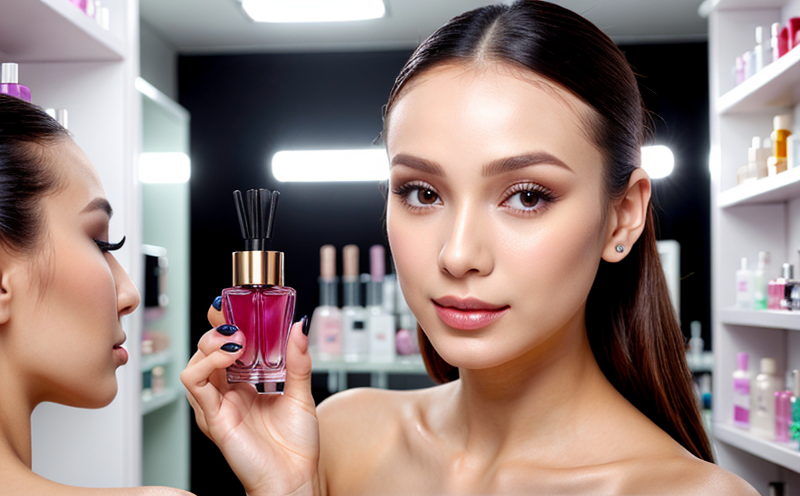Stability Testing of Perfume in Cosmetic Formulations
The stability testing of perfume in cosmetic formulations is a critical process that ensures the long-term quality and performance of perfumes used in cosmetics. This test evaluates how various environmental factors, such as temperature, humidity, light exposure, and storage conditions, affect the chemical composition, fragrance integrity, and overall stability of perfume ingredients over time.
Stability testing plays a pivotal role in ensuring that cosmetic products meet regulatory standards and consumer expectations for consistent quality. Regulatory bodies around the world, including the FDA, the EC, and various national authorities, mandate such tests to ensure product safety and efficacy.
During this testing process, perfumes are subjected to controlled environmental conditions that simulate real-world scenarios. This includes temperature variations ranging from extremely cold (-20°C) to very hot (50°C), humidity levels of up to 93% RH, and exposure to different light types including UV-A, UV-B, and visible light. These tests help determine the shelf life and stability of perfumes under various conditions.
The testing process typically involves several steps: formulation preparation, initial analysis, placement in test chambers, periodic sampling, re-analysis, and final evaluation. Each step is meticulously documented to ensure compliance with relevant standards such as ISO 25096-1:2014 and ASTM D7388.
The results of these tests are essential for quality control, ensuring that perfumes retain their original fragrance attributes over time. This not only enhances consumer satisfaction but also helps companies avoid potential issues such as product recalls or non-compliance with regulations.
| Environmental Factor | Description |
|---|---|
| Temperature | Ranges from -20°C to 50°C, simulating extreme temperature conditions. |
| Humidity | Up to 93% Relative Humidity (RH), representing high-humidity environments. |
| Light Exposure | Involves UV-A, UV-B, and visible light exposure to simulate real-world conditions. |
The results of stability testing are used by quality managers, compliance officers, R&D engineers, and procurement teams to make informed decisions about product development, formulation adjustments, and packaging designs. This ensures that perfumes remain stable and effective throughout their shelf life, meeting both regulatory requirements and consumer expectations.
Scope and Methodology
The scope of stability testing includes assessing the impact of environmental factors on the chemical composition, fragrance integrity, and overall stability of perfume ingredients in cosmetic formulations. The methodology involves subjecting perfumes to controlled environmental conditions that simulate real-world scenarios.
- Temperature Variations: From -20°C to 50°C
- Humidity Levels: Up to 93% Relative Humidity (RH)
- Light Exposure: UV-A, UV-B, and visible light
The testing process typically involves several steps: formulation preparation, initial analysis, placement in test chambers, periodic sampling, re-analysis, and final evaluation. Each step is meticulously documented to ensure compliance with relevant standards such as ISO 25096-1:2014 and ASTM D7388.
The results of these tests are essential for quality control, ensuring that perfumes retain their original fragrance attributes over time. This not only enhances consumer satisfaction but also helps companies avoid potential issues such as product recalls or non-compliance with regulations.
Industry Applications
The results of stability testing are used by quality managers, compliance officers, R&D engineers, and procurement teams to make informed decisions about product development, formulation adjustments, and packaging designs. This ensures that perfumes remain stable and effective throughout their shelf life, meeting both regulatory requirements and consumer expectations.
| Industry | Description |
|---|---|
| Cosmetics | Evaluation of perfume stability in cosmetic formulations. |
| Retail | Assessment of product shelf life and consumer satisfaction. |
| Regulatory Compliance | Ensuring adherence to international standards and regulations. |
The findings from stability testing are crucial for ensuring that perfumes meet quality and safety standards, thereby enhancing consumer trust and satisfaction. This is particularly important in the cosmetics industry where product integrity is paramount.
Why Choose This Test
- Ensures Quality: Guarantees consistent quality of perfumes over time.
- Meets Regulatory Standards: Ensures compliance with international standards such as ISO 25096-1:2014 and ASTM D7388.
- Enhances Consumer Satisfaction: Maintains fragrance integrity, ensuring a positive consumer experience.
- Avoids Product Recalls: Reduces the risk of product recalls due to quality issues.
- Supports Product Development: Provides valuable data for formulation adjustments and packaging designs.
- Improves Brand Reputation: Enhances brand reputation by ensuring high-quality products.
- Cost-Effective: Prevents costly product recalls and rejections.
These benefits make stability testing an essential part of the cosmetic industry, ensuring that perfumes remain stable and effective throughout their shelf life, meeting both regulatory requirements and consumer expectations.





